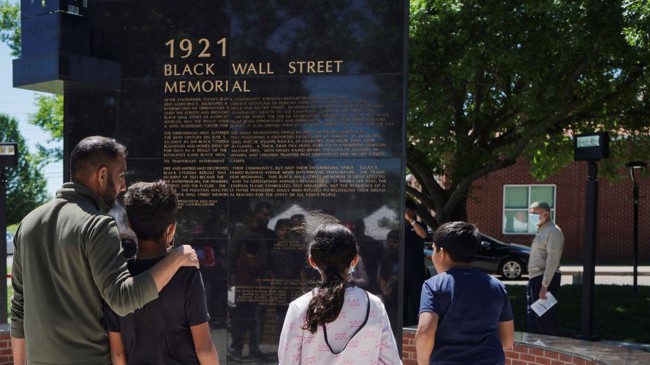
Struggle for truth and justice remains an uphill battle
Racism is America’s original sin. Its manifestations are myriad, and notwithstanding occasional spurts of progress, the struggle for justice continues to be an uphill battle.
First, there is the vicious history of the unspeakable depredations against African Americans. Then there is something which is almost equally risible—a continuous history of denial and obfuscation of America’s dark past.
Take the massacre in Tulsa, Oklahoma in 1921.
On May 31, 1921, white citizens, aided by local law enforcement officials and National Guard troops, destroyed the segregated African American affluent Greenwood community, known as the “Black Wall Street” and home to an estimated 10,000 African American residents. The trigger was a false rumour of an assault of a white girl by a young African American man. White goons looted and set more than 1,250 homes ablaze, according to an official government report commissioned almost 80 years later. An estimated 300 residents were killed.
A subsequent cover-up and denial meant history books are silent about the massacre.
“For the better part of a century, Tulsa did little to remember the victims of the massacre. There was no memorial, no yearly commemoration, and even many Tulsa residents knew little about it. Residents began marking the day with modest ceremonies in 1996,” the New York Times reports.
Tulsa is by no means alone. Many other massacres are not taught in schools. Here’s a select list from The Washington Post:
In Colfax, Louisiana, in 1873, an estimated 62 to 81 African Americans were killed in an attack on newly enfranchised African Americans during Reconstruction. Whites contested the result of the 1872 election (sound familiar?). African American men gathered around the county courthouse to protect the local government. A white mob surrounded them, set the courthouse on fire and shot everyone who came out.
In Wilmington, North Carolina in 1898, white supremacists overthrew the result of a local election and killed dozens of African Americans, burning down Wilmington’s prosperous African American neighbourhood.
Among dozens of racist attacks and massacres across the United States in the “Red Summer” in 1919, one of the worst was in Elaine, Arkansas. At least 200 African American farmers and their families were slaughtered after they had unionised and planned to bypass sharecropping.
It is in this context that US President Joe Biden’s trip to Tulsa to commemorate the 100th anniversary of the massacre is so heartening.
“For much too long, the history of what took place here was told in silence,” Biden said. “While darkness can hide much, it erases nothing.”
“My fellow Americans, this was not a riot,” he said, as people in the crowd rose to their feet. “This was a massacre.”
Biden’s visit suggests that the police murder of George Floyd, an African American just over a year ago, triggering a global mass movement against racism, has brought a change in the public mood.
It also underscores the fact that elections have consequences. It cannot be coincidental that Biden’s robust defence of civil rights follows his presidential campaign essentially brought back from the death by African American Democratic Party primary voters.
Biden is the first US president to visit the site, and that in itself is a mainstream public acknowledgement that is significant.
But beyond the symbolism, substantive measures that address this injustice remain elusive.
Three known survivors of the 1921 Tulsa massacres, all centurions, recently appeared before a congressional subcommittee.
Viola Ford Fletcher, 107; Hughes Van Ellis, her 100-year-old younger brother; and Lessie Benningfield Randle, 106 (who joined remotely) argued that justice was overdue.
“I have lived through the massacre every day,” Fletcher said. “Our country may forget this history, but I cannot,” Fletcher said. She was 7 at that time.
Ellis said the survivors had been made to feel that they were “unworthy of justice, that we were less valued than whites.”
“We aren’t just black-and-white pictures on a screen,” he said. “We are flesh and blood. I was there when it happened. I’m still here.”
“People in positions of power, many just like you, have told us to wait,” Randle said. “Others have told us it’s too late. It seems that justice in America is always so slow, or not possible for Black people. And we are made to feel crazy just for asking for things to be made right.”
All of the House Judiciary subcommittee members—Democrats and Republicans—rose for standing ovations after the survivors spoke.
Survivors accused the city of turning what remains of Greenwood, now just half a block, into a tourist destination, and using their stories to enrich others but not the victims themselves. In 2005, the Supreme Court declined to hear a case brought by the massacre survivors.
Hollywood film star Tom Hanks has joined a growing call on schools to acknowledge and teach about America’s dark past.
“Should our schools now teach the truth about Tulsa? Yes, and they should also stop the battle to whitewash curriculums to avoid discomfort for students. America’s history is messy but knowing that makes us a wiser and stronger people. 1921 is the truth, a portal to our shared, paradoxical history. An American African American Wall Street was not allowed to exist, was burned to ashes; more than 20 years later, World War II was won despite institutionalised racial segregation; more than 20 years after that, the Apollo missions put 12 men on the moon while others were struggling to vote,” Hanks wrote in a guest essay in the New York Times.
END

Be the first to comment